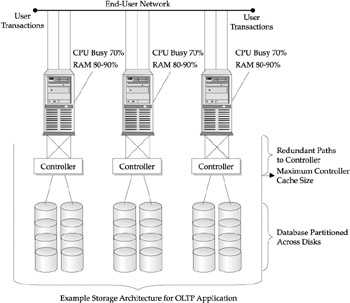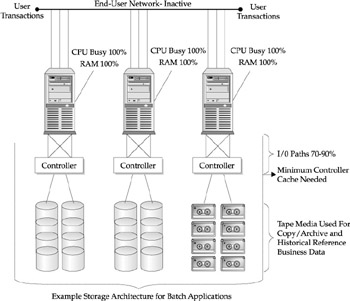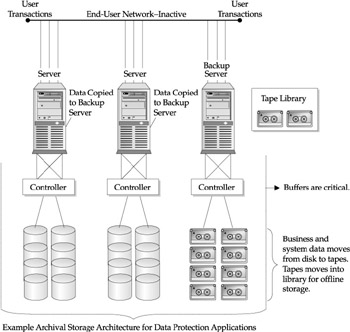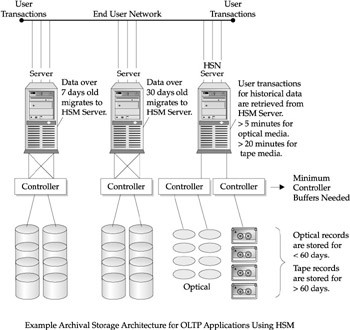Storage Systems
| |
Storage systems have been evolving to logical stand-alone extensions to the client/server processing architecture (refer to Chapters 1 and 2). Consequently, we have storage systems that are larger, in terms of floor space, than the servers they connect to, and costlier, in terms of dollars with software and IT administration. Storage infrastructure costs make up nearly 75 percent of the cost of a client/server configuration. Why? Because we require more and more data to be available onlinein other words, to be available to the end users through some form of interactive application. The result is more disks being attached to the client/server model. With the increase in the number of devices, the resulting complexity in meeting these demands is enabled through the Data Storage Hierarchy.
So, what makes up storage systems for the data center? There are multiple components that make up the storage infrastructure that has evolved into a highway for moving data. As discussed previously, the objective for these components has not changed that is, they are used to stage data as close to the central processing units as possible, and as we have demonstrated, extend the storage highway into the servers themselves . This can drive the boundaries of the traditional views of storage into new perspectives and extend the discussion of what makes up storage systems for the data center. For our discussion, we have simplified our taxonomy to encompass the major functional configurations in which storage systems are deployed. To accomplish this, we have included in our examples the components that continued to be housed in the server. By way of definition and illustration, we have also added a new definition to our discussion, the workload. Consider Figure 5-3 when viewing our examples.

Figure 5-3: The definition of workloads
Typical Storage System Configurations
Online storage systems define a variety of configurations used to support applications that require immediate access to business and systems data, as shown in Figure 5-4. These configurations form the basis for support of many of the additional workloads required to operate the data center.

Figure 5-4: An online storage system
OLTP Workload and Typical Configurations
Online Transaction Processing (OLTP) storage systems are configured with high- performance storage hardware and software components to support business applications in processing transactions in a real-time setting. These environments employ a predefined end- user response time that has a prescribed set of business data operating within several conditional states.
Application performance is expressed as service levels within the data center. Service levels are guarantees or targets defined between end-user and data center management. These generally consist of elements of application availability (up time) and performance (response time). Additional information and discussion can be found in Part VI.
Batch Workload and Typical Configurations
Batch processing storage systems are configured to support applications that are processed in a background fashion and which dont support end-user access, but that nonetheless require immediate access to business and systems data to meet a predefined elapsed time interval for processing. These environments are often highly integrated with OLTP environments and process data captured as a result of the OLTP system, as shown in Figure 5-5. However, unlike OLTP systems, they are usually optimized toward high throughput without regard to transactional service levels or response times. Additional discussions in Part VI will address the interaction between batch and OLTP workloads and the impact they can have on their respective service levels.

Figure 5-5: A batch storage system
Archival Storage
Archival storage depicts a system used to support applications that archive business and systems data no longer needed for online applications, or the copies of business and systems data needed for recovery operations in the event of system outages, data corruption, or disaster planning.
Data Protection Configurations
Data protection storage systems are configured to support maintenance applications that copy data in both logical and segmented forms for later reconstruction. Most are processed in a background fashion and therefore dont support end-user access, but nonetheless require immediate access to business and systems data to meet predefined elapsed time intervals for processing. These environments are often highly integrated with both OLTP and batch environments and provide recovery of business and systems data in the event of various system outages. These systems are usually optimized toward high throughput without regard to transactional service levels or response times, as shown in Figure 5-6.

Figure 5-6: The data protection workload
Near-Line Storage Configurations
Hierarchical Storage Management (HSM) storage systems ( illustrated in Figure 5-7) typically support OLTP applications but are configured with lower performance, and higher capacity, storage hardware, and software components. These systems support a business applications capability to process transactions in a near-real time setting, meaning that some user transactions are asynchronous and can take longer to complete as compared to real-time OLTP response times. However, these environments run with a predefined end-user response time, that although longer, runs with a prescribed set of business data that operates within several conditional states.

Figure 5-7: A typical configuration for HSM workloads
In all fairness to the complexities of large data centers, these systems, in practice, are integrated within the existing production configurations. For example, in most cases the online storage configuration that supports the OLTP application is the same one that supports the batch cycle during an off-shift cycle. Whether this is the most effective for batch workloads is a discussion of our first corollary: speed and capacity versus price. The archive system is often integrated into systems that support some level of HSM or near-line system. Again, whether it interferes with backup jobs run at night is a discussion of our second corollary: speed and capacity versus reliability.
Consequently, when evaluating storage systems, one must take into account the multifunction requirements placed upon it. The likelihood that the most end-user sensitive configurations, such as OLTP- and HSM-like workloads, will take precedence in resources and administration is quite high. These are the systems that generally provide support for the end users day-to-day business operations and which bring visibility to its customers.
With our global definitions and typical workloads, the online storage (OLTP) configurations will form the primary foundation for the storage infrastructure. This will be enhanced and augmented with other, albeit less time-sensitive applications, such as HSM supported applications, the application batch cycle, and last but not least, the archival of data, backup, and recovery jobs necessary for data protection, disaster planning, and legal purposes.
| |
EAN: 2147483647
Pages: 192